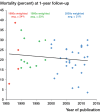Similar mortality rates in hip fracture patients over the past 31 years
- PMID: 24397744
- PMCID: PMC3940992
- DOI: 10.3109/17453674.2013.878831
Similar mortality rates in hip fracture patients over the past 31 years
Abstract
Background: Over 320,000 hip fractures occur in North America each year and they are associated with a mortality rate ranging from 14% to 36% within 1 year of surgery. We assessed whether mortality and reoperation rates have improved in hip fracture patients over the past 31 years.
Methods: 3 electronic databases were searched for randomized controlled trials on hip fracture management, published between 1950 and 2013. Articles that assessed the surgical treatment of intertrochanteric or femoral neck fractures and measured mortality and/or reoperation rates were obtained. We analyzed overall mortality and reoperation rates, as well as mortality rates by fracture type, comparing mean values in different decades. Our primary outcome was the change in 1-year postoperative mortality.
Results: 70 trials published between 1981 and 2012 were included in the review. Overall, the mean 1-year mortality rate changed from 24% in the 1980s to 23% in the 1990s, and to 21% after 1999 (p = 0.7). 1-year mean mortality rates for intertrochanteric fractures diminished from 34% to 23% in studies published before 2000 and after 1999 (p = 0.005). Mean mortality rates for femoral neck fractures were similar over time (~20%). Reoperation rates were also similar over time.
Interpretation: We found similar mortality and reoperation rates in surgically treated hip fracture patients over time, with the exception of decreasing mortality rates in patients with intertrochanteric fractures.
Figures


References
-
- Butler M, Forte ML, Joglekar SB, et al. Evidence summary: Systematic review of surgical treatments for geriatric hip fractures. J Bone Joint Surg (Am) 2011;93(12):1104–15. - PubMed
-
- Carandang R, Seshadri S, Beiser A, et al. Trends in incidence, lifetime risk, severity, and 30-day mortality of stroke over the past 50 years. JAMA. 2006;296(24):2939–46. - PubMed
-
- Cooper C, Campion G, Melton LJ. Hip fractures in the elderly: a world-wide projection. Osteoporos Int. 1992;2(6):285–9. - PubMed
Publication types
MeSH terms
LinkOut - more resources
Full Text Sources
Other Literature Sources
Medical
Miscellaneous
